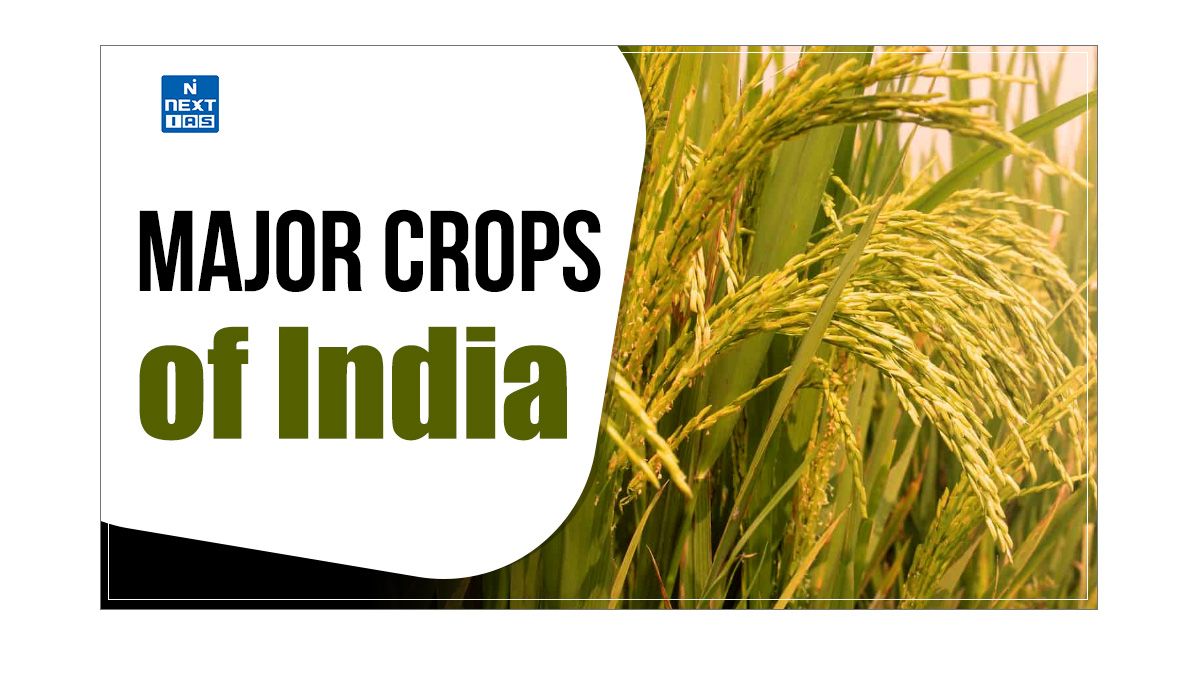
The Green Revolution refers to agricultural innovations and practices introduced in the 1960s and 1970s that significantly increased food production, particularly in developing countries like India. Its significance lies in its role in transforming agricultural practices, leading to food security, economic growth, and the reduction of hunger and poverty. This article aims to study in detail the various aspects of the Green Revolution, including its origins, components, phases, and impact on society and the environment.
About Green Revolution
- Green Revolution refers to the multiple crop production growth in third-world countries based on modern inputs, technologies, HYVs (High-Yielding Varieties), farm mechanisation, and irrigation facilities.
- It reflects the agroeconomic situation of developing countries that aim for self-sufficiency in agriculture and mitigate food crises, hunger, famine, and related social evils.
History of Green Revolution in India
- The Green Revolution in India began in the mid-1960s as a response to severe food shortages and the threat of famine.
- It introduced high-yielding varieties (HYVs) of wheat and rice, developed primarily in Mexico and the Philippines, to increase agricultural productivity.
- Led by Dr M.S. Swaminathan, known as the “Father of the Green Revolution in India,” and supported by agronomist Norman Borlaug, this movement focused on adopting advanced farming techniques, including chemical fertilizers, pesticides, and improved irrigation methods.
- The Green Revolution had its most significant impact in Punjab, Haryana, and Western Uttar Pradesh. It transformed India into a food-self-sufficient nation but also led to challenges like soil degradation and water overuse.
Components of Green Revolution in India
The basis of the Green Revolution in India can be seen in the following points:
- High-yielding varieties (HYVs) – These genetically modified seeds yield 2 to 3 times more than regular crops.
- They are dwarf varieties with dense canopies. Because they are very tender and fragile, they need more water, chemical fertilisers, and protection from pests and weeds.
- It also requires on-farm activities like soil preparation. It has a short generation period and leads to greater production in a short period.
- The short duration of growth means that land is used for the next crop, thus increasing cropping intensity.
- Irrigation Facilities – In 1960, India’s net irrigated area was only 30 million hectares, and extending irrigation to the rest of India was daunting.
- Credit and Financing – This requires an excellent rural credit and microfinancing network to support farmers’ needs.
- Commercialisation of Agriculture – The introduction of Minimum Support Prices for crops gave farmers an extra reason to grow crops.
- Farm Mechanization – It was required to increase crop production.
- The Command Area Development Program (CADP), introduced in 1974, comprised two main components:
- On-Farm Development Activities – This included constructing agricultural channels, ploughing, levelling, and bunding.
- Off-Farm Development Activities – This focused on building roads, improving rural connectivity, and enhancing marketing, transportation, and communication.
- Use of Chemical Fertilizers – Due to soil nitrogen deficiency, NPK fertilizers were applied in a standard ratio of 4:2:1, though the actual usage ratio was 8.2:4.2:1. The use of insecticides, pesticides, and weedicides was also common.
- Rural Electrification – This was essential for advancing farm mechanisation practices.
- Land Holding and Land Reforms – Landholding involved consolidating land, while land reforms included abolishing intermediaries, ending Zamindari, and implementing tenancy reforms.
Phases of Green Revolution in India
Phase I (1965-66 to 1980)
- India needed an immediate food supply and self-sufficiency in food grain production.
- This phase was both crop-specific and region-specific because the agriculture infrastructure was well-developed in Punjab, Haryana, and Western Uttar Pradesh. Also, this region was free from natural hazards.
- This phase started with the Intensive Agriculture Development Program (IADP) and the Intensive Agriculture Area Programme (IAAP) on an experimental basis. Still, the main initiative was the HYV program during the Annual Plan of 1965-66.
- 1974, the Command Area Development Program reemphasised the Green Revolution in India.
- Food production in 1950-51 was merely 25 MT and 33 MT in 1965-66. 1980 it jumped to 100 MT, a threefold increase in 10 years.
- It was more centralised towards wheat production, which increased by 2.5 times in 5 years. This was termed the Green Revolution.
- This provided India with self-sufficiency in food grain production, and the incidences of malnutrition, famine, poverty, and starvation were mitigated. India was successful in coming out of the ‘Begging Bowl image’.
Phase II (1980-1991)
- Wet agriculture (mainly rice) was targeted during the 6th and 7th five-year plans.
- During the first phase, rice production increased merely 1.5 times. Regions with more than 100 cm of rainfall, such as West Bengal, Bihar, Eastern Uttar Pradesh, Assam, and coastal plains, were targeted.
- These plans met with partial success. The Krishna-Godavari delta and Cauvery basin yielded the coveted results.
- West Bengal also showed increased productivity, and in Bihar, Bhojpur experienced the fruits of the Green Revolution.
- However, the full potential of rice productivity was not realised due to institutional factors like land reforms, tenancy, etc.
- Land reforms should have been implemented in areas like UP, West Bengal, and Bihar, but they were not implemented at the right time.
- The traditional outlook of farmers was also a major limiting factor in the success of the Second phase of the Green Revolution.
Phase III (1991-2003)
- During the 8th and 9th five-year plans, dry land agriculture was targeted, and HYV was introduced into cotton, oilseeds, pulses, millets, etc. This met with partial success.
- The Integrated Watershed Management Programme was initiated to improve conditions in sub-humid and semi-arid regions of India.
- However, it was unsuccessful except in the Narmada—Tapi doab, the Tungabhadra basin, and the Bhima—Krishna basin.
- After the 9th five-year plan ended, there was a paradigm shift in government policies.
- The ecological repercussions in the green revolution areas led to a relatively new concept of balanced Agriculture growth based on agricultural ecology, conservation methods, and sustainable development (10th five-year plan).
- The entire agricultural sector was addressed through what is known as the Rainbow Revolution.
- During the 1980s, this initiative encompassed several key revolutions:
- the Yellow Revolution for oilseeds,
- the Blue Revolution for fisheries,
- the White Revolution for dairy,
- the Brown Revolution for fertilisers, and
- the Silver Revolution for poultry.
- The 11th Plan shifted the focus towards sustainable agriculture and balanced growth, which is now termed inclusive growth.
Impact of Green Revolution in India
- The Green Revolution in India remained area- and crop-specific, culminating in regional disparities and increasing ethnic regionalism and consciousness.
- The economic advantages are perceptible, but the social disadvantages have been far more accentuated than the former.
- Capitalistic Farming led to marginal farmers selling land to large farmers who offered high prices, and thus, marginal farmers became labourers.
- Chemical fertilisers, pesticides, etc., have negatively affected the environment, ecology, soil, land, and water of North-western India.
- Thus, the Green Revolution in India was neither futuristic nor visionary and was unsustainable.
Economic Impact
- Interpersonal disparity emerged, leading to differences between people due to differences in earning at different places.
- Inter-regional disparity emerged due to differences in crop production, e.g., between West UP and East UP.
- Interstate disparity emerged.
- For example, in 1960, Punjab and Bihar contributed the same in crop production, but due to the Green Revolution, there became a huge gap in crop production between the two states by 1990.
- Due to the increase in informal credit services, labourers and cultivators fell into the vicious cycle of debt traps.
Social Impact
- Increased rural landlessness, smaller marginal farmers were rendered landless and became agricultural labourers, which led to rural handicaps and health hazards.
- Greater unemployment due to mechanisation.
- Patriarchy was strengthened, female discrimination, female foeticide, and dowry increased.
Ecological Impact
- Soil degradation due to unscientific farming methods led to salinisation, alkalisation, formation of reh, Kallar, etc.
- Excessive use of irrigation has led to the issue of water logging in Green Revolution areas.
- The Green Revolution in India led to the toxication of soil from unwanted chemicals, which was caused by the excessive use of fertilisers.
- The Green Revolution in India increased water pollution, degrading water quality in rivers, tanks, and reservoirs.
- Eutrophication is the enrichment of one element or nutrient that results in a boom of certain species-specific plants.
- For example, excessive nitrogen in tanks and ponds leads to the growth of water hyacinths.
- Due to eutrophication, natural ecosystems die.
- For example, the excessive growth of water hyacinths kills the pond ecosystem because Sun rays and oxygenation decrease in lower water layers.
- The Green Revolution in India led to large-scale deforestation, especially in the Punjab, Tarai, and Bhabhar regions, where forests were cleared for agricultural purposes.
- The Green Revolution in India also led to disruption in agricultural ecology by crop monoculture (E.g., due to crop monoculture of wheat, many people say India has only a wheat rev
- olution), and the use of pesticides, fertilisers, and weedicides.
Advantages of Green Revolution in India
- It was pertinent for a country with a perennial food crisis and population explosion.
- It led to the removal of hunger and famine.
- It gave rise to capitalistic farming practices in India.
- The surplus was generated in agriculture, which led to its commercialisation.
- It led to the development of rural infrastructure, which was a pre-condition for the Green Revolution.
- It made it self–sufficient in food grain production.
- The financial burden due to agriculture imports was reduced, which could now be channelled into various poverty alleviation programs, e.g., the Backward Area Development Programme, IRDP, Tribal Area Development Program, etc.
- The increase in wage rate led to the availability of cash to the farmers.
- Developing agro-processing and food-processing industries led to the industrialisation of tier II/III towns and a higher urbanisation rate.
- Population increases during the 1960s–80s required a higher food supply, which was only possible during the Green Revolution. The population increased from 33 crores to 66 crores within a 25-year gap.
- It led to the mechanisation of agriculture.
- Land reforms, consolidation of land holding, etc., were implemented in Green Revolution areas.
- The forward and backward linkages of agriculture with industries strengthened.
- Forward linkages refer to the industry’s supply of raw materials, while backward linkages refer to the industry’s demand for raw materials.
Disadvantages of Green Revolution in India
The disadvantages of the Green Revolution are as follows:
- While the Green Revolution significantly boosted agricultural productivity, it also led to several disadvantages.
- The heavy reliance on chemical fertilisers and pesticides degraded soil, reducing long-term soil fertility and leading to water pollution from runoff.
- The intensive use of water resources for irrigation contributed to groundwater depletion and the over-extraction of surface water, causing water scarcity in many regions.
- Additionally, the Green Revolution led to the exploitation of land and created an imbalance, benefiting wealthier farmers with access to resources while neglecting small and marginal farmers.
- This led to increased inequality and economic disparities in rural areas.
- Finally, focusing on a few high-yield crops reduced biodiversity, making the agricultural system more vulnerable to pests and diseases.
| Analysis of Green Revolution in India | |
| Arguments Against | Arguments in Favour |
| Spread to a limited area. | Increase in production. |
| Benefits to rich farmers only. | Increase in areas of cultivation. |
| Increase in unemployment. | Led to economic and social balance. |
| Pollution of drinking water and soil degradation. | High standard of living. |
| Increase in economic inequality. | Benefit to all. |
Conclusion
The Green Revolution successfully achieved its primary goal of food sufficiency for India. With this significant milestone reached, the focus now shifts towards promoting sustainable agricultural patterns. By expanding the principles of the Green Revolution to cover a broader area and integrating practices that ensure long-term ecological balance, the initiative can evolve into what we term the Evergreen Revolution. This transformation aims to build on past successes while addressing contemporary challenges, ensuring productive and environmentally sustainable agricultural growth.
Frequently Asked Questions (FAQs)
What is the Green Revolution?
The Green Revolution was a significant agricultural advancement starting in the 1960s, marked by the introduction of high-yield crop varieties, chemical fertilisers, pesticides, and modern irrigation techniques.
Who is the father of Green Revolution?
Norman Borlaug is often called the “Father of the Green Revolution.”
Who started Green Revolution in India?
M. S. Swaminathan is often credited with leading the Green Revolution in India.






